人教版 (2019) 选择性必修 第二册 Unit 3 Food and Culture Reading and Thinking课件(共31张PPT,内嵌视频)
文档属性
| 名称 | 人教版 (2019) 选择性必修 第二册 Unit 3 Food and Culture Reading and Thinking课件(共31张PPT,内嵌视频) | 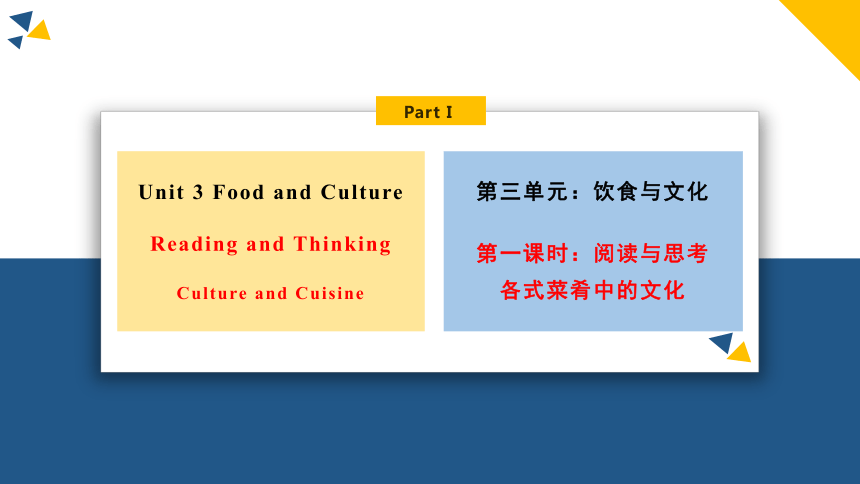 | |
| 格式 | pptx | ||
| 文件大小 | 67.2MB | ||
| 资源类型 | 教案 | ||
| 版本资源 | 人教版(2019) | ||
| 科目 | 英语 | ||
| 更新时间 | 2023-08-17 13:35:57 | ||
图片预览

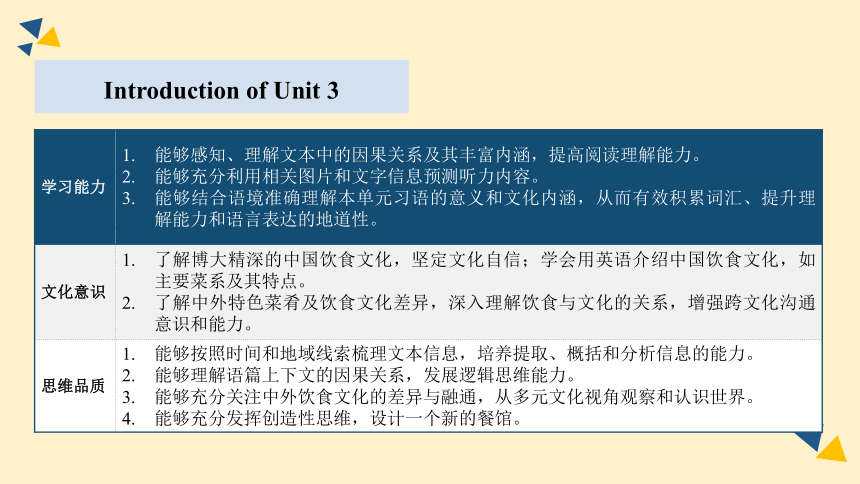
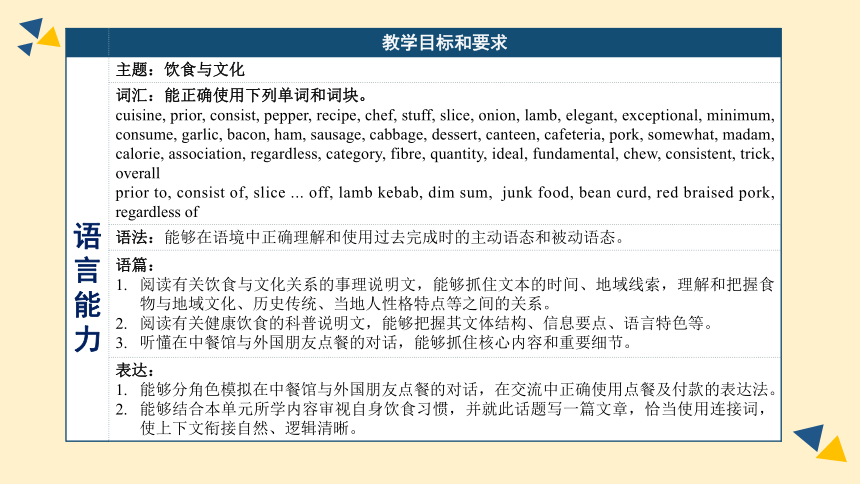

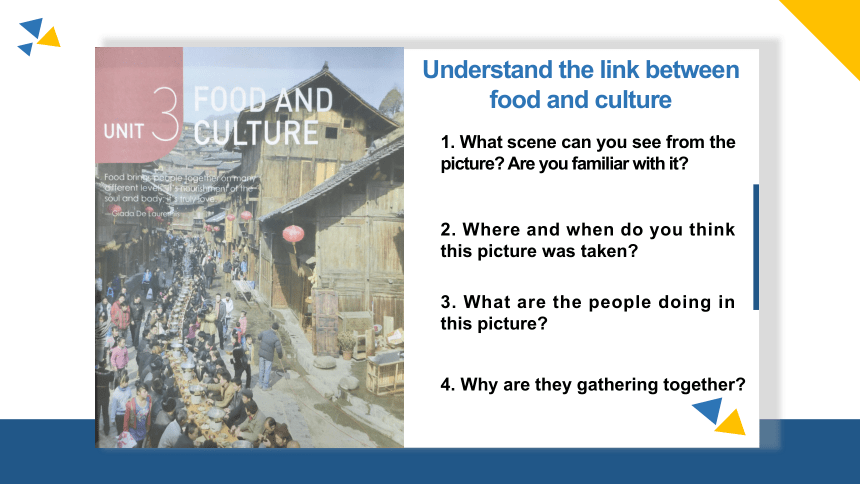
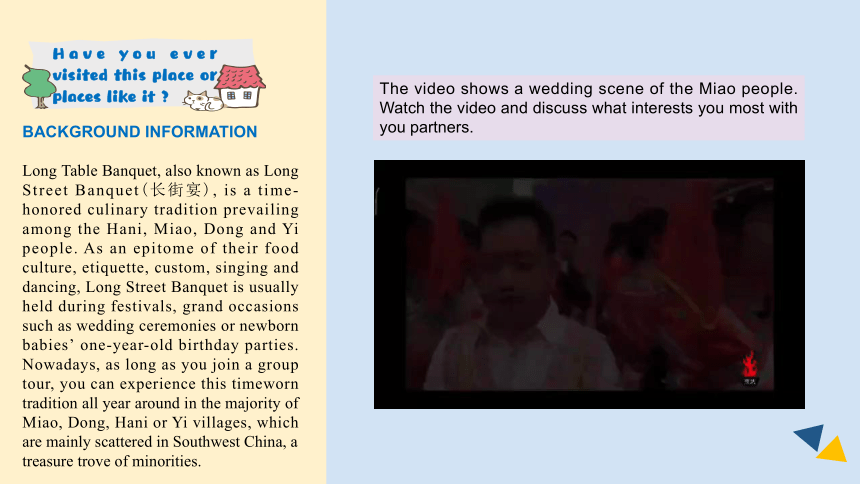
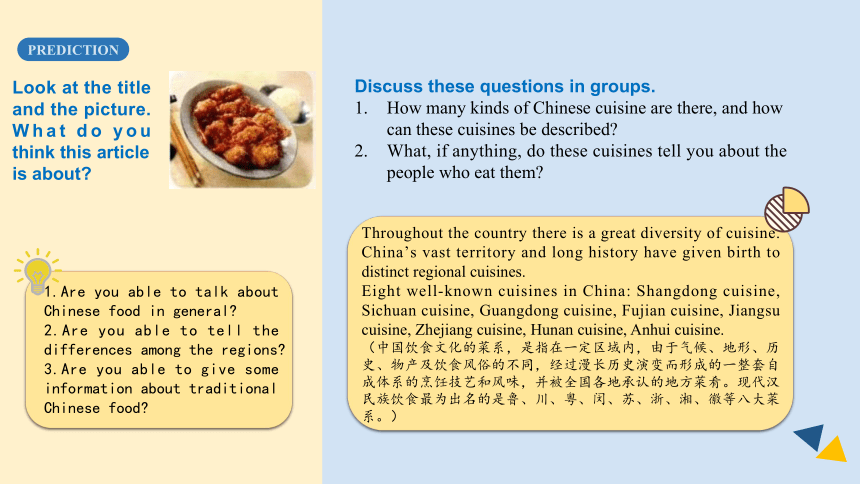
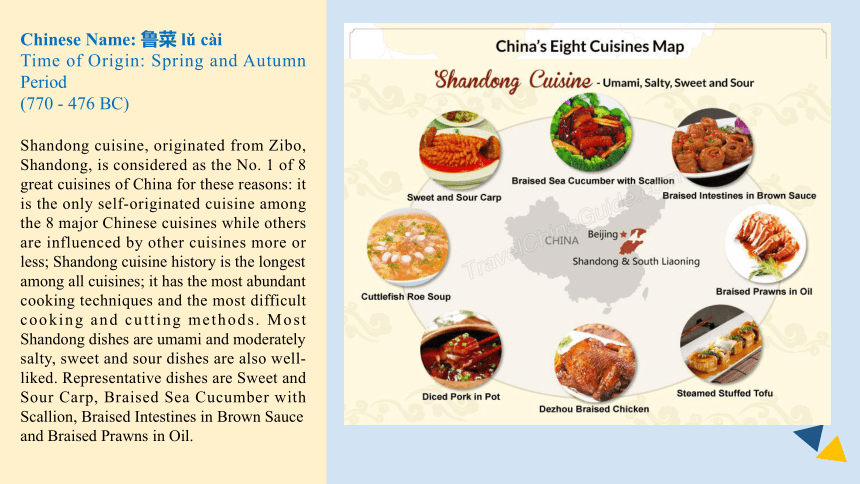
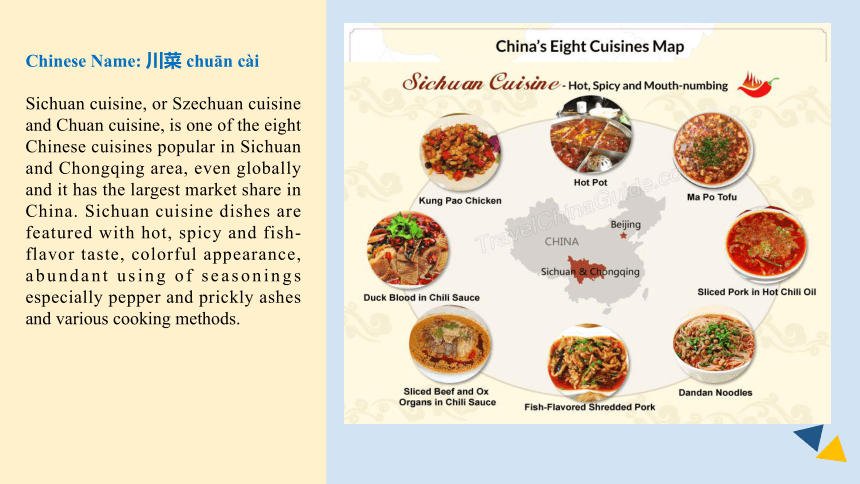
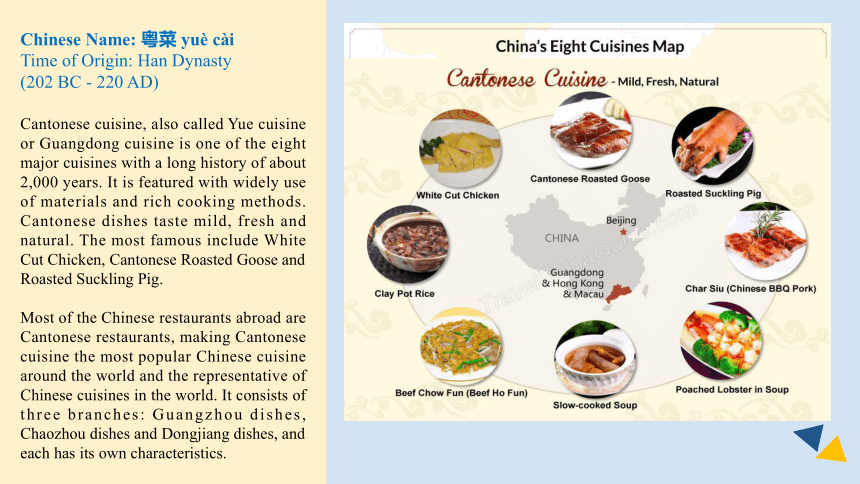
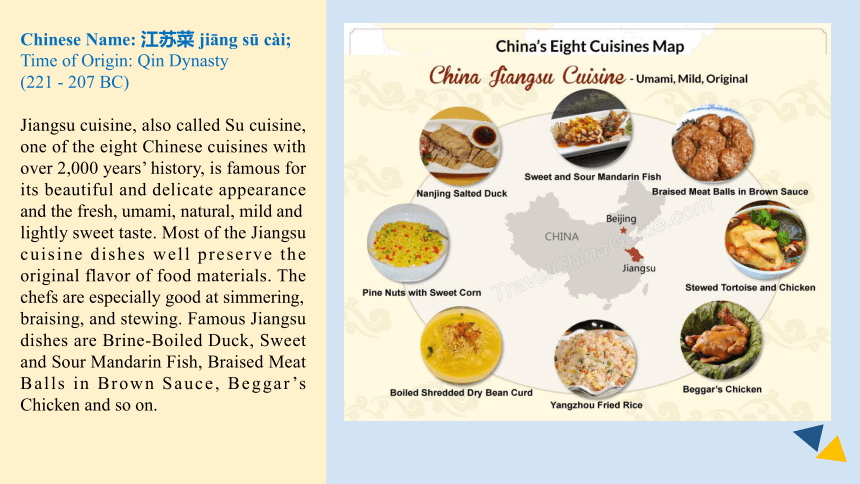
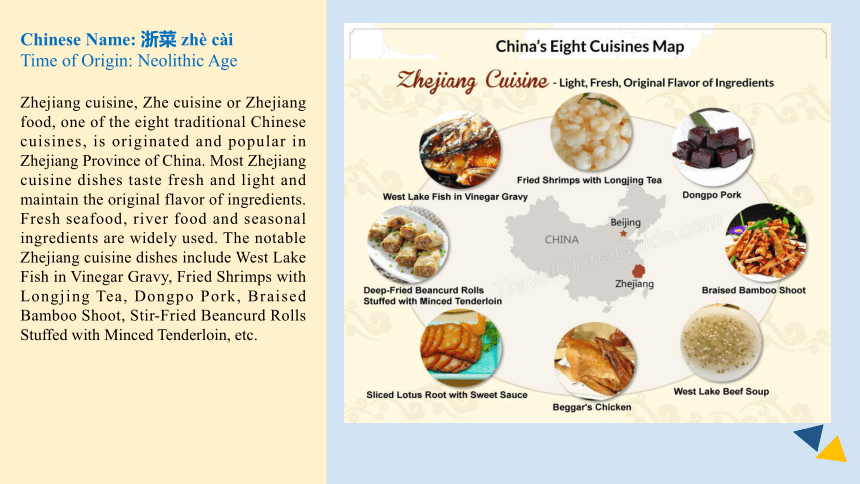
文档简介
(共31张PPT)
Part I
Unit 3 Food and Culture
Reading and Thinking
Culture and Cuisine
第三单元:饮食与文化
第一课时:阅读与思考
各式菜肴中的文化
Introduction of Unit 3
学习能力 能够感知、理解文本中的因果关系及其丰富内涵,提高阅读理解能力。
能够充分利用相关图片和文字信息预测听力内容。
能够结合语境准确理解本单元习语的意义和文化内涵,从而有效积累词汇、提升理解能力和语言表达的地道性。
文化意识 了解博大精深的中国饮食文化,坚定文化自信;学会用英语介绍中国饮食文化,如主要菜系及其特点。
了解中外特色菜肴及饮食文化差异,深入理解饮食与文化的关系,增强跨文化沟通意识和能力。
思维品质 能够按照时间和地域线索梳理文本信息,培养提取、概括和分析信息的能力。
能够理解语篇上下文的因果关系,发展逻辑思维能力。
能够充分关注中外饮食文化的差异与融通,从多元文化视角观察和认识世界。
能够充分发挥创造性思维,设计一个新的餐馆。
教学目标和要求
语 言 能 力 主题:饮食与文化
词汇:能正确使用下列单词和词块。
cuisine, prior, consist, pepper, recipe, chef, stuff, slice, onion, lamb, elegant, exceptional, minimum, consume, garlic, bacon, ham, sausage, cabbage, dessert, canteen, cafeteria, pork, somewhat, madam, calorie, association, regardless, category, fibre, quantity, ideal, fundamental, chew, consistent, trick, overall
prior to, consist of, slice ... off, lamb kebab, dim sum, junk food, bean curd, red braised pork, regardless of
语法:能够在语境中正确理解和使用过去完成时的主动语态和被动语态。
语篇:
阅读有关饮食与文化关系的事理说明文,能够抓住文本的时间、地域线索,理解和把握食物与地域文化、历史传统、当地人性格特点等之间的关系。
阅读有关健康饮食的科普说明文,能够把握其文体结构、信息要点、语言特色等。
听懂在中餐馆与外国朋友点餐的对话,能够抓住核心内容和重要细节。
表达:
能够分角色模拟在中餐馆与外国朋友点餐的对话,在交流中正确使用点餐及付款的表达法。
能够结合本单元所学内容审视自身饮食习惯,并就此话题写一篇文章,恰当使用连接词,使上下文衔接自然、逻辑清晰。
食物在许多不同的层面上把人们聚集在一起,它是心灵和身体的养料,是真正的爱。
——吉娅达·德·劳伦蒂斯
名言
Understand the link between
food and culture
1. What scene can you see from the picture Are you familiar with it
2. Where and when do you think this picture was taken
3. What are the people doing in this picture
4. Why are they gathering together
background information
Long Table Banquet, also known as Long Street Banquet(长街宴), is a time-honored culinary tradition prevailing among the Hani, Miao, Dong and Yi people. As an epitome of their food culture, etiquette, custom, singing and dancing, Long Street Banquet is usually held during festivals, grand occasions such as wedding ceremonies or newborn babies’ one-year-old birthday parties. Nowadays, as long as you join a group tour, you can experience this timeworn tradition all year around in the majority of Miao, Dong, Hani or Yi villages, which are mainly scattered in Southwest China, a treasure trove of minorities.
Have you ever visited this place or places like it
The video shows a wedding scene of the Miao people. Watch the video and discuss what interests you most with you partners.
任务2
prediction
Look at the title and the picture. What do you think this article is about
1.Are you able to talk about Chinese food in general
2.Are you able to tell the differences among the regions
3.Are you able to give some information about traditional Chinese food
Discuss these questions in groups.
How many kinds of Chinese cuisine are there, and how can these cuisines be described
What, if anything, do these cuisines tell you about the people who eat them
Throughout the country there is a great diversity of cuisine. China’s vast territory and long history have given birth to distinct regional cuisines.
Eight well-known cuisines in China: Shangdong cuisine, Sichuan cuisine, Guangdong cuisine, Fujian cuisine, Jiangsu cuisine, Zhejiang cuisine, Hunan cuisine, Anhui cuisine.
(中国饮食文化的菜系,是指在一定区域内,由于气候、地形、历史、物产及饮食风俗的不同,经过漫长历史演变而形成的一整套自成体系的烹饪技艺和风味,并被全国各地承认的地方菜肴。现代汉民族饮食最为出名的是鲁、川、粤、闵、苏、浙、湘、徽等八大菜系。)
Chinese Name: 鲁菜 lǔ cài
Time of Origin: Spring and Autumn Period
(770 - 476 BC)
Shandong cuisine, originated from Zibo, Shandong, is considered as the No. 1 of 8 great cuisines of China for these reasons: it is the only self-originated cuisine among the 8 major Chinese cuisines while others are influenced by other cuisines more or less; Shandong cuisine history is the longest among all cuisines; it has the most abundant cooking techniques and the most difficult cooking and cutting methods. Most Shandong dishes are umami and moderately salty, sweet and sour dishes are also well-liked. Representative dishes are Sweet and Sour Carp, Braised Sea Cucumber with Scallion, Braised Intestines in Brown Sauce and Braised Prawns in Oil.
Chinese Name: 川菜 chuān cài
Sichuan cuisine, or Szechuan cuisine and Chuan cuisine, is one of the eight Chinese cuisines popular in Sichuan and Chongqing area, even globally and it has the largest market share in China. Sichuan cuisine dishes are featured with hot, spicy and fish-flavor taste, colorful appearance, abundant using of seasonings especially pepper and prickly ashes and various cooking methods.
Chinese Name: 粤菜 yuè cài
Time of Origin: Han Dynasty
(202 BC - 220 AD)
Cantonese cuisine, also called Yue cuisine or Guangdong cuisine is one of the eight major cuisines with a long history of about 2,000 years. It is featured with widely use of materials and rich cooking methods. Cantonese dishes taste mild, fresh and natural. The most famous include White Cut Chicken, Cantonese Roasted Goose and Roasted Suckling Pig.
Most of the Chinese restaurants abroad are Cantonese restaurants, making Cantonese cuisine the most popular Chinese cuisine around the world and the representative of Chinese cuisines in the world. It consists of three branches: Guangzhou dishes, Chaozhou dishes and Dongjiang dishes, and each has its own characteristics.
Chinese Name: 江苏菜 jiāng sū cài;
Time of Origin: Qin Dynasty
(221 - 207 BC)
Jiangsu cuisine, also called Su cuisine, one of the eight Chinese cuisines with over 2,000 years’ history, is famous for its beautiful and delicate appearance and the fresh, umami, natural, mild and lightly sweet taste. Most of the Jiangsu cuisine dishes well preserve the original flavor of food materials. The chefs are especially good at simmering, braising, and stewing. Famous Jiangsu dishes are Brine-Boiled Duck, Sweet and Sour Mandarin Fish, Braised Meat Balls in Brown Sauce, Beggar’s Chicken and so on.
Chinese Name: 浙菜 zhè cài
Time of Origin: Neolithic Age
Zhejiang cuisine, Zhe cuisine or Zhejiang food, one of the eight traditional Chinese cuisines, is originated and popular in Zhejiang Province of China. Most Zhejiang cuisine dishes taste fresh and light and maintain the original flavor of ingredients. Fresh seafood, river food and seasonal ingredients are widely used. The notable Zhejiang cuisine dishes include West Lake Fish in Vinegar Gravy, Fried Shrimps with Longjing Tea, Dongpo Pork, Braised Bamboo Shoot, Stir-Fried Beancurd Rolls Stuffed with Minced Tenderloin, etc.
Chinese Name: 徽菜 huī cài
Anhui cuisine, or simply Hui cuisine, is originated over 1,000 years ago from Huizhou, the current Shexian County at the foot of Yellow Mountain in Anhui Province. Anhui cuisine is one of the eight Chinese cuisines. The ingredients are mostly from the wild, and the flavor is light. Anhui cuisine attaches importance to dietetic invigoration with natural ingredients. The representative dishes and Anhui cuisine desserts include Stinky Mandarin Fish, Fried Hairy Tofu, Steamed Partridge, Stewed Bamboo Shoots of Wenzheng Mountain, Huangshan Stewed Pigeon, Li Hongzhang Chop Suey, etc.
Chinese Name: 闽菜 mǐn cài
Fujian cuisine or Min cuisine, is one of the eight major cuisines in China popular in Fujian, Taiwan and some Southeast Asian countries. Fujian cuisine dishes taste light but flavorful, fresh, mellow and not greasy in general. Woodland delicacies and seafoods are frequently used with varied cooking methods. The chefs take cutting skills and seasonings seriously, and the condiments often used include red vinasse, sugar, vinegar, satay, shrimp sauce and so on. Soups are frequently seen Fujian cuisine dishes like Boiled Sea Clam with Chicken Soup. Other well-known ones include Buddha Jumps Over the Wall, Sweet and Sour Litchis, and Sliced Whelk in Red Vinasse.
Chinese Name: 湘菜 xiāng cài
Hunan Cuisine / Xiang Cuisine – Hot, Spicy, Salty
Hunan cuisine, also called Xiang cuisine, is one of the eight cuisines in China, which is popular not only in Hunan Province, but in the whole China. Hunan cuisine is welcomed abroad as well, such as the United States, Europe, Japan, and Southeast Asia. It has an aromatic and spicy flavor as pepper is the most important condiment. Its representative dishes include Steamed Fish Head with Chopped Chili, Fried Pork with Chili, Tasty Lobster, Changsha Stinky Tofu, Hunan Rice Noodles, Dong’an Chicken, and Spicy Salted Duck, etc.
任务1
Paragraph Main idea
1
2
3
4
5
6
7
Lead readers in the topic by explaining the quote “You are what you eat.”
Chinese food in America has changed to suit American flavor.
My experience of authentic Chinese food in Beijing.
What I learn about in Chinese food culture in Shandong Province.
Cuisine in Xinjiang
Cuisine in South China
What can various kinds of food tell us.
The first paragraph has a quote: “You are what you eat.” In pairs, discuss what you think this saying means. Then read the article to see if you share the same ideas as the author. Meanwhile, fill in the chart with the main idea of each paragraph.
Culture and Cuisine
CULTURE AND CUISINE
The French author Jean Anthelme Brillat-Savarin once wrote, “Tell me what you eat, and I will tell you what you are.” Put more simply, this means “You are what you eat.” Most people today relate this saying to healthy eating. However, Brillat-Savarin was actually referring to our personality, character, and culture.
Certainly, in many ways this seems to be true. Chinese cuisine is a case in point. Prior to coming to China, my only experience with Chinese cooking was in America, with Chinese food that had been changed to suit American tastes. For example, America’s most popular Chinese dish is General Tso’s chicken, which consists of fried chicken covered in a sweet sauce, flavoured with hot red peppers. This is probably not an authentic Chinese recipe, however, so it cannot tell us much about the Chinese. On the other hand, it does tell us a lot about Americans. It tells us, for example, that Americans love bold, simple flavours. And, since the dish was also invented recently, it tells us that Americans are not afraid to try new foods.
How does the writer understand the quote
The food we are eating or we enjoy cooking relates a lot to our personality, character, and culture.
Example:
General Tso’s chicken
American’s
recipe
American’s personality
课文阅读
What are his comments towards these cuisines
课文阅读
Later, I had a chance to experience authentic Chinese food by coming to China.When my family and I had just arrived in China, we went looking for a good place to eat in Beijing. A Sichuan restaurant had been recommended to us by a friend, and finally, we found it. Tired, hungry, and not knowing a word of Chinese, we had no idea how to order, so the chef just began filling our table with the best food we had ever eaten. With this, we had the pleasure of experiencing an entirely new taste: Sichuan peppercorns. The food was wonderful and different, but what was even more important was the friendship offered us.
Why did the writer feel friendship from the food they had in Beijing
Paragraph 3-6 is about author’s experience of foods in different regions of China.
We soon moved to Shandong Province in the eastern part of North China. My favourite dish there was boiled dumplings served with vinegar. I observed that family is important to the people there. It has become a favourite traditional dish of the people in North China, where making dumplings has always been a family affair with everyone — from the youngest to the oldest — joining in to help. Later, I learnt that the most famous food in Shandong is pancake rolls stuffed with sliced Chinese green onions.
Then we moved to northern Xinjiang. Some of our friends were Kazak and Inner Mongolian. These groups traditionally wandered the open range on horses. As a result, their traditional foods are what you can cook over an open fire — usually boiled or roasted meat, such as lamb kebab.
课文阅读
Our travels then took us to South China, and then on to central China. In each place we went, we experienced wonderful local dishes, from Guangdong’s elegant dim sum — small servings of food in bamboo steamers — to the exceptional stewed noodles in Henan. Everywhere, the food was as varied as the people. However, one thing is always true: Through food, Chinese people everywhere show friendship and kindness.
At a minimum, the kinds of food local people consume tell us what they grow in their region, what kinds of lives they lead, and what they like and do not like. Could we also say, for example, that those who like bold flavours are bold themselves Or, that those who like spicy food tend to have a hot temper Maybe. Maybe not. What we can say, however, is that culture and cuisine go hand in hand, and if you do not experience one, you can never really know the other.
WHAT is a food and WHAT is not a food
HOW food is prepared and by whom
WHO eats the food and with whom
HOW often and WHEN foods are eaten
Do people have taste preferences or special meaning of food
课文阅读
Following the author’s steps, we have a brief study about foods in different regions of China.
Read the last paragraph carefully. Think about these questions with the passage and your own knowledge.
任务2
思考并带着这些问题在课文中找答案
拓展阅读
It tells people that Americans love bold, simple flavors and are not afraid to try new foods.
Family.
Because it had been recommended to them by a friend.
They traditionally wandered the open range on horses.
1. What does the dish General Tso’s chicken tell about Americans
3. What did the writer find is important to people in China while he was in Shandong
4. Why did people in Xinjiang enjoy cooking over an open fire
5. What does the food local people consume tell the writer
2. Why did the writer and his family go to a Sichuan restaurant in Beijing
It tells us what people grow in their region and what kinds of lives they lead, what they like or dislike.
General Tso’s chicken is named for Tso Tsung-tang, a 19th-century general who is one of their best-known historical figures. But although many Chinese dishes are named after famous person, there is no record of any dish named after Tso. In 1949, Chiang Kai-shek and Nationalist Party fled to the island of Taiwan. They took with them many talented people, including a number of notable chefs, and foremost among them was Peng Chang-kuei. He created this dish in the1950s, and brought it with him when he moved to the U.S. in 1973, making it sweeter for American palates. This version is adapted from the original, hot and sour and lacking the sweetness of its Americanized counterpart.
Use the information from the text to complete the table below.
Place Kind of Chinese food Typical dish People or culture
America Chinese food changed to suit American tastes General Tso’s chicken Americans love bold, simple flavours, and are not afraid to try new foods.
Beijing Sichuan cuisine dishes with Sichuan peppercorns People there offered them good friendship.
Shandong Shangdong cuising boiled dumplings served with vinegar; pancake rolls stuffed with sliced Chinese green onions Family is important to the people there.
Northwest China Xinjiang and Inner Mongolian cuisine boiled or roasted meat, such as lamb kebab People there traditionally wandered the open range on horses so their traditional foods are what you can cook over an open fire.
South China Guangdong cuisine dim sum Through food, Chinese people everywhere show friendship and kindness.
Central China Henan cuisine stewed noodles
Even in immigrant countries like American, different ethnic groups keep their own food habits. Read the information below, it is about different people’s core foods. Have you ever tried these core foods in your meals
任务3
任务4
Match the causes to the effects below. Then find more examples from the text.
Effect
The chef just began filling our table with the best food we had ever eaten.
Their traditional foods are what you can cook over an open fire.
Chinese food in America is changed to suit American tastes.
Cause
The flavour preferences of Americans often differ from those of the Chinese.
We had no idea how to order food.
These groups traditionally wandered the open range on horses.
Understand cause and effect
Sometimes two ideas are related to each other by cause and effect. That is, one thing causes something else to happen. Cause-and-effect relationships can be direct. For example, “It was raining. so l took my umbrella.” However, some cause-and-effect relationships are not direct, and some may also have more than one cause or effect.
4. … family is important to the
people there (Shan Dong).
……
D. Making dumplings has always
been a family affair with
everyone.
……
What conclusion does the author get after his experience in China
culture and cuisine go hand in hand
句式讲解
【句式剖析】本句是一个强调句,强调的是句子中的谓语动词tell,由于时态是一般现在时,主语是第三人称单数形式,所以借助动词does表强调。该强调形式只能用于肯定句中。
She does go to school by bus every day.
她的确每天乘公共汽车去上学。
1. On the other hand, it does tell us a lot about Americans.
另一方面,它确实告诉了我们很多关于美国人的事情。
【句式拓展】
对句中的谓语动词进行强调时,需要根据主语的人称及句子的时态借助助动词do/does/did来表示。
I do hope I can be chosen as a spokesman for polar bears.
我的确希望能被选中担任北极熊代言人。
I did call her last night, but I didn’t get through.
我昨晚的确给她打电话了,但是没接通。
Do be careful when you are crossing the street next time.
下次过马路时一定要小心。
really 真的(普通语气)
exactly 严格来讲,确切来说,从准确度来说
truly 真实地,真诚地,从情感上来说
actually 实际上,事实上
=in fact 从实际事情上出发,和事实比较
indeed 确实,实在;真正地,多么(一般用在句尾)
表
强
调的用法
2. Tired, hungry, and not knowing a word of Chinese, we had no idea how to order, so the chef just began filling our table with the best food we had ever eaten.
我们又累又饿,而且一句汉语也不会,压根儿不知道如何点餐。于是(便让)厨师尽管把食物往桌子上摆,那可是我们吃过的最棒的饭菜。
【句式剖析】Tired, hungry, and not knowing a word of Chinese是we had no idea ... 的状语,and并列连接了形容词和动词-ing形式,表示当时“我们”所处的状态。同时,前面部分又和so the chef just began ... 并列,表达因果关系。tired, hungry是形容词作状语,说明谓语动词发生时主语所处的状态。
Tired and hungry, the man refused to go on with the work.
又累又饿,那个人拒绝继续工作。
Busy with his work, he has no time to go to the movie.
忙于工作,他没有时间去看电影。
【句式拓展】形容词作状语在句中可以表示行为方式或伴随状况、原因、时间或条件等。
For a moment I just stood there, and saw the deep water, afraid.
我在那儿呆呆地站了一会儿,非常害怕地看着深深的水。
句式讲解
参考翻译
法国作家让·安泰尔姆·布里亚-萨瓦兰曾写道:“告诉我你吃什么,我就能知道你是什么样的人。”更简单地说,这就是说“人如其食”。今天大多数人把这句话和健康饮食联系起来,然而布里亚-萨瓦兰实际上指的是我们的个性、性格和文化。
当然,在很多方面这句话似乎是正确的。中国菜肴就是一个恰当的例子。在来中国之前,我对中国烹饪的唯一体验是美国中餐,他们已经做了改变,以满足美国人的口味。例如美国最受欢迎的中国菜“左宗棠甜辣鸡”是用甜酱汁,包括炸鸡用红辣椒调味。然而这可能不是正宗的中餐做法,因此并不能让我们对中国人了解多少。不过在另一方面,它确实让我们对美国人了解很多。例如,这道菜说明美国人喜欢浓烈、简单的口味。此外,由于这道菜也是新发明,说明美国人并不惧怕尝试新的菜品。
后来我有机会来到中国品尝地道的中国菜。我和家人刚到中国时,在北京寻找吃饭的好地方。一位朋友向我们推荐了一家川菜馆,最终我们找到了这家餐馆。我们又累又饿,而且一句中文也不会,我们根本不知道如何点餐,所以厨师径自在我们的桌上摆满食物,那是我们吃过的最可口的佳肴。因此我们很高兴地体验了一种全新的口味:四川花椒。这种食物美味又与众不同,但更重要的是我们感受到的友好。
参考翻译
很快我们就到了华北地区东部的山东省。在那里我最喜欢的食物是蘸醋水饺。我发现对那里的人来说,家庭很重要,水饺已成为华北地区最受人们喜爱的传统食物,在那里包饺子一直是全员参与的家庭活动,无论老少都要加入其中帮忙。后来我才知道,山东最有名的食物是煎饼卷大葱。
后来我们到了新疆北部。我们的一些朋友是哈萨克族和内蒙古人。传统上,他们骑着马在广阔的草原上漫步。因此,他们的传统食物在篝火上烹制而成,通常是煮熟的或烤熟的肉,比如羊肉串。
后来我们又游历了华南地区,随后去了华中地区。去每一个地方,我们都会品尝当地的美食,有广东精致的点心——放在竹蒸笼里蒸出来的小份食品,还有河南独特的烩面。所到之处的美食与当地人一样精彩纷呈。然而,有一件事始终不变:每个地方的中国人都通过食物展现友情和善意。
当地人使用的食物种类至少告诉我们,他们在当地种植什么,过着什么样的生活,他们喜欢和不喜欢什么。比如我们可以说那些喜欢重口味的人性格粗犷,或者说喜欢辛辣食物的人脾气往往比较火暴。也许是,也许不是。然而,我们可以确定的是,文化和美食是紧密相关的,如果你没有体验过其中一个,就永远不能真正了解另外一个。
课后练习
II. 课文语法填空
According to the French author Jean Anthelme Brillat-Savarin,
we eat can show our personality, character, and culture. Chinese cuisine is a good example. Prior to (come) to China, I only experienced Chinese food that (change) to suit American tastes. America’s most popular Chinese dish is General Tso’s chicken, which tells us a lot about us Americans.
When I came to Beijing, a friend recommended a Sichuan restaurant where we had the (please) of experiencing an entirely new taste: Sichuan peppercorns. What was even _______ important was the friendship offered us. In Shandong, I liked boiled dumplings (serve) with vinegar best. I observed that family is important to the people there. In northern Xinjiang, I enjoyed boiled or roasted meat. we went, we experienced wonderful local dishes. Although the food was as (vary) as the people, Chinese people everywhere show friendship and _____ (kind) through food. From my experiences, I know that culture and cuisine go hand in hand, and if you do not experience one, you can never (real) know the other.
KEYS:
I.
1. consumed 2. maximum; minimum 3.consist 4.Prior 5. priority
II.
what; coming; had been changed; pleasure; more; served; Everywhere; varied; kindness; really
I. 根据汉语及首字母提示完成句子。
1. He was ______ (充满内心) with jealousy.
2. We aim to get the __________ (最大量)
benefit with the _______(最小量) effect.
3. Water ________ of hydrogen and oxygen.
(含有)
4. ______ to the meeting, we discussed the
matter. (在……之前)
5. The students’ safety is the ______ of our
school. (首先有考虑的事情).
Spaghett is a long, thin, solid, cylindrical (圆柱形的) noodle pasta. It is a staple food of traditional Italian cuisine. Like other pasta, spaghetti is made of milled wheat and water and sometimes enriched with vitamins and minerals. Italian spaghetti is typically made from durum wheat semolina. Usually the pasta is white because refined flour is used, but whole wheat flour may be added.
IV. 看视频,阅读下面材料并翻译成汉语。
细式意大利面是一种又长又细、质地结实的圆柱形面条。它是意大利传统菜肴的主食。像其他意式面条一样,它是由磨碎的小麦和水做成的,有时还添加了维生素和矿物质。意大利细面通常是用硬粒小麦粗磨粉做的。因为使用精制面粉,通常面团是白色的,但有时也会添加全麦面粉。
课后练习
参考范文:
What we eat represents our personality, character, and culture, and Chinese cuisine is a good example. (要点1)
I travelled to many places in China with my family and tasted many different kinds of local food. (要点2)
Though everywhere the food was as varied as the people, one thing is certain: Chinese people show friendship and kindness through food. (要点3)
Culture and cuisine go hand in hand. (要点4)
IⅡ. 概要写作
根据课本P26—P27内容写一篇60词左右的内容概要。
For example, you can talk about soup!
活动:Food Traditions:
The Thread That Links...
When was it
(A holiday An ordinary day )
Was the food prepared quickly
Where was it shared
(At home Restaurant Countryside )
Were you exploring new foods together OR eating old family favorites
Do you like similar foods to what the rest of your family likes
Do you like anything the rest of your family can’t stand or has never tried
Think about a time when food made you feel especially connected to your family.
Think of your childhood and a soup your mother/grandmother/aunt prepared.
If your father/grandfather/uncle prepared it, think about why.
Think of the ingredients.
Think of sayings about the soup.
Think of when and how it was served.
Think of who prepares it now.
Think of how you prepare it or why you don’t.
……
……
Thanks for Your Consideration!
Part I
Unit 3 Food and Culture
Reading and Thinking
Culture and Cuisine
第三单元:饮食与文化
第一课时:阅读与思考
各式菜肴中的文化
Introduction of Unit 3
学习能力 能够感知、理解文本中的因果关系及其丰富内涵,提高阅读理解能力。
能够充分利用相关图片和文字信息预测听力内容。
能够结合语境准确理解本单元习语的意义和文化内涵,从而有效积累词汇、提升理解能力和语言表达的地道性。
文化意识 了解博大精深的中国饮食文化,坚定文化自信;学会用英语介绍中国饮食文化,如主要菜系及其特点。
了解中外特色菜肴及饮食文化差异,深入理解饮食与文化的关系,增强跨文化沟通意识和能力。
思维品质 能够按照时间和地域线索梳理文本信息,培养提取、概括和分析信息的能力。
能够理解语篇上下文的因果关系,发展逻辑思维能力。
能够充分关注中外饮食文化的差异与融通,从多元文化视角观察和认识世界。
能够充分发挥创造性思维,设计一个新的餐馆。
教学目标和要求
语 言 能 力 主题:饮食与文化
词汇:能正确使用下列单词和词块。
cuisine, prior, consist, pepper, recipe, chef, stuff, slice, onion, lamb, elegant, exceptional, minimum, consume, garlic, bacon, ham, sausage, cabbage, dessert, canteen, cafeteria, pork, somewhat, madam, calorie, association, regardless, category, fibre, quantity, ideal, fundamental, chew, consistent, trick, overall
prior to, consist of, slice ... off, lamb kebab, dim sum, junk food, bean curd, red braised pork, regardless of
语法:能够在语境中正确理解和使用过去完成时的主动语态和被动语态。
语篇:
阅读有关饮食与文化关系的事理说明文,能够抓住文本的时间、地域线索,理解和把握食物与地域文化、历史传统、当地人性格特点等之间的关系。
阅读有关健康饮食的科普说明文,能够把握其文体结构、信息要点、语言特色等。
听懂在中餐馆与外国朋友点餐的对话,能够抓住核心内容和重要细节。
表达:
能够分角色模拟在中餐馆与外国朋友点餐的对话,在交流中正确使用点餐及付款的表达法。
能够结合本单元所学内容审视自身饮食习惯,并就此话题写一篇文章,恰当使用连接词,使上下文衔接自然、逻辑清晰。
食物在许多不同的层面上把人们聚集在一起,它是心灵和身体的养料,是真正的爱。
——吉娅达·德·劳伦蒂斯
名言
Understand the link between
food and culture
1. What scene can you see from the picture Are you familiar with it
2. Where and when do you think this picture was taken
3. What are the people doing in this picture
4. Why are they gathering together
background information
Long Table Banquet, also known as Long Street Banquet(长街宴), is a time-honored culinary tradition prevailing among the Hani, Miao, Dong and Yi people. As an epitome of their food culture, etiquette, custom, singing and dancing, Long Street Banquet is usually held during festivals, grand occasions such as wedding ceremonies or newborn babies’ one-year-old birthday parties. Nowadays, as long as you join a group tour, you can experience this timeworn tradition all year around in the majority of Miao, Dong, Hani or Yi villages, which are mainly scattered in Southwest China, a treasure trove of minorities.
Have you ever visited this place or places like it
The video shows a wedding scene of the Miao people. Watch the video and discuss what interests you most with you partners.
任务2
prediction
Look at the title and the picture. What do you think this article is about
1.Are you able to talk about Chinese food in general
2.Are you able to tell the differences among the regions
3.Are you able to give some information about traditional Chinese food
Discuss these questions in groups.
How many kinds of Chinese cuisine are there, and how can these cuisines be described
What, if anything, do these cuisines tell you about the people who eat them
Throughout the country there is a great diversity of cuisine. China’s vast territory and long history have given birth to distinct regional cuisines.
Eight well-known cuisines in China: Shangdong cuisine, Sichuan cuisine, Guangdong cuisine, Fujian cuisine, Jiangsu cuisine, Zhejiang cuisine, Hunan cuisine, Anhui cuisine.
(中国饮食文化的菜系,是指在一定区域内,由于气候、地形、历史、物产及饮食风俗的不同,经过漫长历史演变而形成的一整套自成体系的烹饪技艺和风味,并被全国各地承认的地方菜肴。现代汉民族饮食最为出名的是鲁、川、粤、闵、苏、浙、湘、徽等八大菜系。)
Chinese Name: 鲁菜 lǔ cài
Time of Origin: Spring and Autumn Period
(770 - 476 BC)
Shandong cuisine, originated from Zibo, Shandong, is considered as the No. 1 of 8 great cuisines of China for these reasons: it is the only self-originated cuisine among the 8 major Chinese cuisines while others are influenced by other cuisines more or less; Shandong cuisine history is the longest among all cuisines; it has the most abundant cooking techniques and the most difficult cooking and cutting methods. Most Shandong dishes are umami and moderately salty, sweet and sour dishes are also well-liked. Representative dishes are Sweet and Sour Carp, Braised Sea Cucumber with Scallion, Braised Intestines in Brown Sauce and Braised Prawns in Oil.
Chinese Name: 川菜 chuān cài
Sichuan cuisine, or Szechuan cuisine and Chuan cuisine, is one of the eight Chinese cuisines popular in Sichuan and Chongqing area, even globally and it has the largest market share in China. Sichuan cuisine dishes are featured with hot, spicy and fish-flavor taste, colorful appearance, abundant using of seasonings especially pepper and prickly ashes and various cooking methods.
Chinese Name: 粤菜 yuè cài
Time of Origin: Han Dynasty
(202 BC - 220 AD)
Cantonese cuisine, also called Yue cuisine or Guangdong cuisine is one of the eight major cuisines with a long history of about 2,000 years. It is featured with widely use of materials and rich cooking methods. Cantonese dishes taste mild, fresh and natural. The most famous include White Cut Chicken, Cantonese Roasted Goose and Roasted Suckling Pig.
Most of the Chinese restaurants abroad are Cantonese restaurants, making Cantonese cuisine the most popular Chinese cuisine around the world and the representative of Chinese cuisines in the world. It consists of three branches: Guangzhou dishes, Chaozhou dishes and Dongjiang dishes, and each has its own characteristics.
Chinese Name: 江苏菜 jiāng sū cài;
Time of Origin: Qin Dynasty
(221 - 207 BC)
Jiangsu cuisine, also called Su cuisine, one of the eight Chinese cuisines with over 2,000 years’ history, is famous for its beautiful and delicate appearance and the fresh, umami, natural, mild and lightly sweet taste. Most of the Jiangsu cuisine dishes well preserve the original flavor of food materials. The chefs are especially good at simmering, braising, and stewing. Famous Jiangsu dishes are Brine-Boiled Duck, Sweet and Sour Mandarin Fish, Braised Meat Balls in Brown Sauce, Beggar’s Chicken and so on.
Chinese Name: 浙菜 zhè cài
Time of Origin: Neolithic Age
Zhejiang cuisine, Zhe cuisine or Zhejiang food, one of the eight traditional Chinese cuisines, is originated and popular in Zhejiang Province of China. Most Zhejiang cuisine dishes taste fresh and light and maintain the original flavor of ingredients. Fresh seafood, river food and seasonal ingredients are widely used. The notable Zhejiang cuisine dishes include West Lake Fish in Vinegar Gravy, Fried Shrimps with Longjing Tea, Dongpo Pork, Braised Bamboo Shoot, Stir-Fried Beancurd Rolls Stuffed with Minced Tenderloin, etc.
Chinese Name: 徽菜 huī cài
Anhui cuisine, or simply Hui cuisine, is originated over 1,000 years ago from Huizhou, the current Shexian County at the foot of Yellow Mountain in Anhui Province. Anhui cuisine is one of the eight Chinese cuisines. The ingredients are mostly from the wild, and the flavor is light. Anhui cuisine attaches importance to dietetic invigoration with natural ingredients. The representative dishes and Anhui cuisine desserts include Stinky Mandarin Fish, Fried Hairy Tofu, Steamed Partridge, Stewed Bamboo Shoots of Wenzheng Mountain, Huangshan Stewed Pigeon, Li Hongzhang Chop Suey, etc.
Chinese Name: 闽菜 mǐn cài
Fujian cuisine or Min cuisine, is one of the eight major cuisines in China popular in Fujian, Taiwan and some Southeast Asian countries. Fujian cuisine dishes taste light but flavorful, fresh, mellow and not greasy in general. Woodland delicacies and seafoods are frequently used with varied cooking methods. The chefs take cutting skills and seasonings seriously, and the condiments often used include red vinasse, sugar, vinegar, satay, shrimp sauce and so on. Soups are frequently seen Fujian cuisine dishes like Boiled Sea Clam with Chicken Soup. Other well-known ones include Buddha Jumps Over the Wall, Sweet and Sour Litchis, and Sliced Whelk in Red Vinasse.
Chinese Name: 湘菜 xiāng cài
Hunan Cuisine / Xiang Cuisine – Hot, Spicy, Salty
Hunan cuisine, also called Xiang cuisine, is one of the eight cuisines in China, which is popular not only in Hunan Province, but in the whole China. Hunan cuisine is welcomed abroad as well, such as the United States, Europe, Japan, and Southeast Asia. It has an aromatic and spicy flavor as pepper is the most important condiment. Its representative dishes include Steamed Fish Head with Chopped Chili, Fried Pork with Chili, Tasty Lobster, Changsha Stinky Tofu, Hunan Rice Noodles, Dong’an Chicken, and Spicy Salted Duck, etc.
任务1
Paragraph Main idea
1
2
3
4
5
6
7
Lead readers in the topic by explaining the quote “You are what you eat.”
Chinese food in America has changed to suit American flavor.
My experience of authentic Chinese food in Beijing.
What I learn about in Chinese food culture in Shandong Province.
Cuisine in Xinjiang
Cuisine in South China
What can various kinds of food tell us.
The first paragraph has a quote: “You are what you eat.” In pairs, discuss what you think this saying means. Then read the article to see if you share the same ideas as the author. Meanwhile, fill in the chart with the main idea of each paragraph.
Culture and Cuisine
CULTURE AND CUISINE
The French author Jean Anthelme Brillat-Savarin once wrote, “Tell me what you eat, and I will tell you what you are.” Put more simply, this means “You are what you eat.” Most people today relate this saying to healthy eating. However, Brillat-Savarin was actually referring to our personality, character, and culture.
Certainly, in many ways this seems to be true. Chinese cuisine is a case in point. Prior to coming to China, my only experience with Chinese cooking was in America, with Chinese food that had been changed to suit American tastes. For example, America’s most popular Chinese dish is General Tso’s chicken, which consists of fried chicken covered in a sweet sauce, flavoured with hot red peppers. This is probably not an authentic Chinese recipe, however, so it cannot tell us much about the Chinese. On the other hand, it does tell us a lot about Americans. It tells us, for example, that Americans love bold, simple flavours. And, since the dish was also invented recently, it tells us that Americans are not afraid to try new foods.
How does the writer understand the quote
The food we are eating or we enjoy cooking relates a lot to our personality, character, and culture.
Example:
General Tso’s chicken
American’s
recipe
American’s personality
课文阅读
What are his comments towards these cuisines
课文阅读
Later, I had a chance to experience authentic Chinese food by coming to China.When my family and I had just arrived in China, we went looking for a good place to eat in Beijing. A Sichuan restaurant had been recommended to us by a friend, and finally, we found it. Tired, hungry, and not knowing a word of Chinese, we had no idea how to order, so the chef just began filling our table with the best food we had ever eaten. With this, we had the pleasure of experiencing an entirely new taste: Sichuan peppercorns. The food was wonderful and different, but what was even more important was the friendship offered us.
Why did the writer feel friendship from the food they had in Beijing
Paragraph 3-6 is about author’s experience of foods in different regions of China.
We soon moved to Shandong Province in the eastern part of North China. My favourite dish there was boiled dumplings served with vinegar. I observed that family is important to the people there. It has become a favourite traditional dish of the people in North China, where making dumplings has always been a family affair with everyone — from the youngest to the oldest — joining in to help. Later, I learnt that the most famous food in Shandong is pancake rolls stuffed with sliced Chinese green onions.
Then we moved to northern Xinjiang. Some of our friends were Kazak and Inner Mongolian. These groups traditionally wandered the open range on horses. As a result, their traditional foods are what you can cook over an open fire — usually boiled or roasted meat, such as lamb kebab.
课文阅读
Our travels then took us to South China, and then on to central China. In each place we went, we experienced wonderful local dishes, from Guangdong’s elegant dim sum — small servings of food in bamboo steamers — to the exceptional stewed noodles in Henan. Everywhere, the food was as varied as the people. However, one thing is always true: Through food, Chinese people everywhere show friendship and kindness.
At a minimum, the kinds of food local people consume tell us what they grow in their region, what kinds of lives they lead, and what they like and do not like. Could we also say, for example, that those who like bold flavours are bold themselves Or, that those who like spicy food tend to have a hot temper Maybe. Maybe not. What we can say, however, is that culture and cuisine go hand in hand, and if you do not experience one, you can never really know the other.
WHAT is a food and WHAT is not a food
HOW food is prepared and by whom
WHO eats the food and with whom
HOW often and WHEN foods are eaten
Do people have taste preferences or special meaning of food
课文阅读
Following the author’s steps, we have a brief study about foods in different regions of China.
Read the last paragraph carefully. Think about these questions with the passage and your own knowledge.
任务2
思考并带着这些问题在课文中找答案
拓展阅读
It tells people that Americans love bold, simple flavors and are not afraid to try new foods.
Family.
Because it had been recommended to them by a friend.
They traditionally wandered the open range on horses.
1. What does the dish General Tso’s chicken tell about Americans
3. What did the writer find is important to people in China while he was in Shandong
4. Why did people in Xinjiang enjoy cooking over an open fire
5. What does the food local people consume tell the writer
2. Why did the writer and his family go to a Sichuan restaurant in Beijing
It tells us what people grow in their region and what kinds of lives they lead, what they like or dislike.
General Tso’s chicken is named for Tso Tsung-tang, a 19th-century general who is one of their best-known historical figures. But although many Chinese dishes are named after famous person, there is no record of any dish named after Tso. In 1949, Chiang Kai-shek and Nationalist Party fled to the island of Taiwan. They took with them many talented people, including a number of notable chefs, and foremost among them was Peng Chang-kuei. He created this dish in the1950s, and brought it with him when he moved to the U.S. in 1973, making it sweeter for American palates. This version is adapted from the original, hot and sour and lacking the sweetness of its Americanized counterpart.
Use the information from the text to complete the table below.
Place Kind of Chinese food Typical dish People or culture
America Chinese food changed to suit American tastes General Tso’s chicken Americans love bold, simple flavours, and are not afraid to try new foods.
Beijing Sichuan cuisine dishes with Sichuan peppercorns People there offered them good friendship.
Shandong Shangdong cuising boiled dumplings served with vinegar; pancake rolls stuffed with sliced Chinese green onions Family is important to the people there.
Northwest China Xinjiang and Inner Mongolian cuisine boiled or roasted meat, such as lamb kebab People there traditionally wandered the open range on horses so their traditional foods are what you can cook over an open fire.
South China Guangdong cuisine dim sum Through food, Chinese people everywhere show friendship and kindness.
Central China Henan cuisine stewed noodles
Even in immigrant countries like American, different ethnic groups keep their own food habits. Read the information below, it is about different people’s core foods. Have you ever tried these core foods in your meals
任务3
任务4
Match the causes to the effects below. Then find more examples from the text.
Effect
The chef just began filling our table with the best food we had ever eaten.
Their traditional foods are what you can cook over an open fire.
Chinese food in America is changed to suit American tastes.
Cause
The flavour preferences of Americans often differ from those of the Chinese.
We had no idea how to order food.
These groups traditionally wandered the open range on horses.
Understand cause and effect
Sometimes two ideas are related to each other by cause and effect. That is, one thing causes something else to happen. Cause-and-effect relationships can be direct. For example, “It was raining. so l took my umbrella.” However, some cause-and-effect relationships are not direct, and some may also have more than one cause or effect.
4. … family is important to the
people there (Shan Dong).
……
D. Making dumplings has always
been a family affair with
everyone.
……
What conclusion does the author get after his experience in China
culture and cuisine go hand in hand
句式讲解
【句式剖析】本句是一个强调句,强调的是句子中的谓语动词tell,由于时态是一般现在时,主语是第三人称单数形式,所以借助动词does表强调。该强调形式只能用于肯定句中。
She does go to school by bus every day.
她的确每天乘公共汽车去上学。
1. On the other hand, it does tell us a lot about Americans.
另一方面,它确实告诉了我们很多关于美国人的事情。
【句式拓展】
对句中的谓语动词进行强调时,需要根据主语的人称及句子的时态借助助动词do/does/did来表示。
I do hope I can be chosen as a spokesman for polar bears.
我的确希望能被选中担任北极熊代言人。
I did call her last night, but I didn’t get through.
我昨晚的确给她打电话了,但是没接通。
Do be careful when you are crossing the street next time.
下次过马路时一定要小心。
really 真的(普通语气)
exactly 严格来讲,确切来说,从准确度来说
truly 真实地,真诚地,从情感上来说
actually 实际上,事实上
=in fact 从实际事情上出发,和事实比较
indeed 确实,实在;真正地,多么(一般用在句尾)
表
强
调的用法
2. Tired, hungry, and not knowing a word of Chinese, we had no idea how to order, so the chef just began filling our table with the best food we had ever eaten.
我们又累又饿,而且一句汉语也不会,压根儿不知道如何点餐。于是(便让)厨师尽管把食物往桌子上摆,那可是我们吃过的最棒的饭菜。
【句式剖析】Tired, hungry, and not knowing a word of Chinese是we had no idea ... 的状语,and并列连接了形容词和动词-ing形式,表示当时“我们”所处的状态。同时,前面部分又和so the chef just began ... 并列,表达因果关系。tired, hungry是形容词作状语,说明谓语动词发生时主语所处的状态。
Tired and hungry, the man refused to go on with the work.
又累又饿,那个人拒绝继续工作。
Busy with his work, he has no time to go to the movie.
忙于工作,他没有时间去看电影。
【句式拓展】形容词作状语在句中可以表示行为方式或伴随状况、原因、时间或条件等。
For a moment I just stood there, and saw the deep water, afraid.
我在那儿呆呆地站了一会儿,非常害怕地看着深深的水。
句式讲解
参考翻译
法国作家让·安泰尔姆·布里亚-萨瓦兰曾写道:“告诉我你吃什么,我就能知道你是什么样的人。”更简单地说,这就是说“人如其食”。今天大多数人把这句话和健康饮食联系起来,然而布里亚-萨瓦兰实际上指的是我们的个性、性格和文化。
当然,在很多方面这句话似乎是正确的。中国菜肴就是一个恰当的例子。在来中国之前,我对中国烹饪的唯一体验是美国中餐,他们已经做了改变,以满足美国人的口味。例如美国最受欢迎的中国菜“左宗棠甜辣鸡”是用甜酱汁,包括炸鸡用红辣椒调味。然而这可能不是正宗的中餐做法,因此并不能让我们对中国人了解多少。不过在另一方面,它确实让我们对美国人了解很多。例如,这道菜说明美国人喜欢浓烈、简单的口味。此外,由于这道菜也是新发明,说明美国人并不惧怕尝试新的菜品。
后来我有机会来到中国品尝地道的中国菜。我和家人刚到中国时,在北京寻找吃饭的好地方。一位朋友向我们推荐了一家川菜馆,最终我们找到了这家餐馆。我们又累又饿,而且一句中文也不会,我们根本不知道如何点餐,所以厨师径自在我们的桌上摆满食物,那是我们吃过的最可口的佳肴。因此我们很高兴地体验了一种全新的口味:四川花椒。这种食物美味又与众不同,但更重要的是我们感受到的友好。
参考翻译
很快我们就到了华北地区东部的山东省。在那里我最喜欢的食物是蘸醋水饺。我发现对那里的人来说,家庭很重要,水饺已成为华北地区最受人们喜爱的传统食物,在那里包饺子一直是全员参与的家庭活动,无论老少都要加入其中帮忙。后来我才知道,山东最有名的食物是煎饼卷大葱。
后来我们到了新疆北部。我们的一些朋友是哈萨克族和内蒙古人。传统上,他们骑着马在广阔的草原上漫步。因此,他们的传统食物在篝火上烹制而成,通常是煮熟的或烤熟的肉,比如羊肉串。
后来我们又游历了华南地区,随后去了华中地区。去每一个地方,我们都会品尝当地的美食,有广东精致的点心——放在竹蒸笼里蒸出来的小份食品,还有河南独特的烩面。所到之处的美食与当地人一样精彩纷呈。然而,有一件事始终不变:每个地方的中国人都通过食物展现友情和善意。
当地人使用的食物种类至少告诉我们,他们在当地种植什么,过着什么样的生活,他们喜欢和不喜欢什么。比如我们可以说那些喜欢重口味的人性格粗犷,或者说喜欢辛辣食物的人脾气往往比较火暴。也许是,也许不是。然而,我们可以确定的是,文化和美食是紧密相关的,如果你没有体验过其中一个,就永远不能真正了解另外一个。
课后练习
II. 课文语法填空
According to the French author Jean Anthelme Brillat-Savarin,
we eat can show our personality, character, and culture. Chinese cuisine is a good example. Prior to (come) to China, I only experienced Chinese food that (change) to suit American tastes. America’s most popular Chinese dish is General Tso’s chicken, which tells us a lot about us Americans.
When I came to Beijing, a friend recommended a Sichuan restaurant where we had the (please) of experiencing an entirely new taste: Sichuan peppercorns. What was even _______ important was the friendship offered us. In Shandong, I liked boiled dumplings (serve) with vinegar best. I observed that family is important to the people there. In northern Xinjiang, I enjoyed boiled or roasted meat. we went, we experienced wonderful local dishes. Although the food was as (vary) as the people, Chinese people everywhere show friendship and _____ (kind) through food. From my experiences, I know that culture and cuisine go hand in hand, and if you do not experience one, you can never (real) know the other.
KEYS:
I.
1. consumed 2. maximum; minimum 3.consist 4.Prior 5. priority
II.
what; coming; had been changed; pleasure; more; served; Everywhere; varied; kindness; really
I. 根据汉语及首字母提示完成句子。
1. He was ______ (充满内心) with jealousy.
2. We aim to get the __________ (最大量)
benefit with the _______(最小量) effect.
3. Water ________ of hydrogen and oxygen.
(含有)
4. ______ to the meeting, we discussed the
matter. (在……之前)
5. The students’ safety is the ______ of our
school. (首先有考虑的事情).
Spaghett is a long, thin, solid, cylindrical (圆柱形的) noodle pasta. It is a staple food of traditional Italian cuisine. Like other pasta, spaghetti is made of milled wheat and water and sometimes enriched with vitamins and minerals. Italian spaghetti is typically made from durum wheat semolina. Usually the pasta is white because refined flour is used, but whole wheat flour may be added.
IV. 看视频,阅读下面材料并翻译成汉语。
细式意大利面是一种又长又细、质地结实的圆柱形面条。它是意大利传统菜肴的主食。像其他意式面条一样,它是由磨碎的小麦和水做成的,有时还添加了维生素和矿物质。意大利细面通常是用硬粒小麦粗磨粉做的。因为使用精制面粉,通常面团是白色的,但有时也会添加全麦面粉。
课后练习
参考范文:
What we eat represents our personality, character, and culture, and Chinese cuisine is a good example. (要点1)
I travelled to many places in China with my family and tasted many different kinds of local food. (要点2)
Though everywhere the food was as varied as the people, one thing is certain: Chinese people show friendship and kindness through food. (要点3)
Culture and cuisine go hand in hand. (要点4)
IⅡ. 概要写作
根据课本P26—P27内容写一篇60词左右的内容概要。
For example, you can talk about soup!
活动:Food Traditions:
The Thread That Links...
When was it
(A holiday An ordinary day )
Was the food prepared quickly
Where was it shared
(At home Restaurant Countryside )
Were you exploring new foods together OR eating old family favorites
Do you like similar foods to what the rest of your family likes
Do you like anything the rest of your family can’t stand or has never tried
Think about a time when food made you feel especially connected to your family.
Think of your childhood and a soup your mother/grandmother/aunt prepared.
If your father/grandfather/uncle prepared it, think about why.
Think of the ingredients.
Think of sayings about the soup.
Think of when and how it was served.
Think of who prepares it now.
Think of how you prepare it or why you don’t.
……
……
Thanks for Your Consideration!
